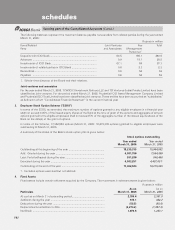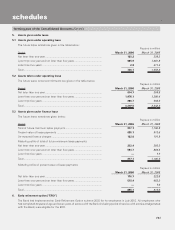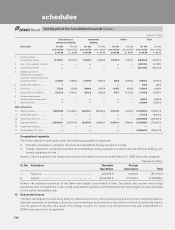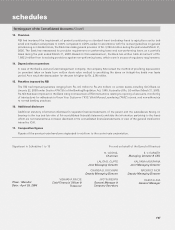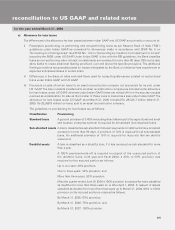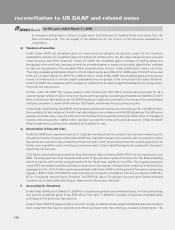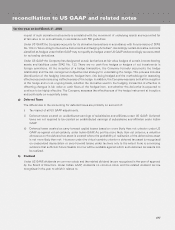ICICI Bank 2006 Annual Report Download - page 131
Download and view the complete annual report
Please find page 131 of the 2006 ICICI Bank annual report below. You can navigate through the pages in the report by either clicking on the pages listed below, or by using the keyword search tool below to find specific information within the annual report.
F72
Loss assets The entire loan is required to be written off or provided for.
Restructured loans A provision equal to the difference between the present value of the future interest
as per the original loan agreement and the present value of the future interest on the
basis of rescheduled terms at the time of restructuring is required to be made.
Under US GAAP, the impaired loans portfolio is classified into restructured loans and other impaired loans.
Restructured loans represent loans whose terms relating to interest and installment payments have been
modified and qualify as troubled debt restructurings as defined in SFAS No. 15 on “Accounting by Debtors
and Creditors for Troubled Debt Restructurings”. Other impaired loans represent loans other than restructured
loans, which qualify for impairment as per SFAS No. 114.
Under US GAAP, larger balance, non-homogenous exposures representing significant individual credit
exposures (both funded and non-funded), are evaluated on the basis of borrower’s overall financial condition,
resources and payment record and the realizable value of any collateral. This estimate considers all available
evidence including the present value of the expected future cash flows discounted at the loan’s contractual
effective rate and the fair value of collateral. Allowances recognised on account of reductions of future
interest rates as a part of troubled debt restructurings are accreted as a credit to the provision for loan
losses over the tenor of the restructured loan. Each portfolio of smaller-balance, homogenous loans, including
consumer mortgage, instalment, revolving credit and most other consumer loans, is individually evaluated
for impairment. The allowance for loan losses attributed to these loans is established via a process that
includes an estimate of probable losses inherent in the portfolio, based upon various statistical analysis.
Under US GAAP, the allowance for loan losses for restructured loans is created by discounting expected
cash flows at contracted interest rates, unlike Indian GAAP, under which current interest rates are used.
Under US GAAP, the allowances include provisions for credit losses on the performing portfolio based on
the estimated probable losses inherent in the portfolio. The allowances on the performing portfolio are
established after considering historical and projected default rates and loss severities.
Under Indian GAAP, in respect of non-performing loan accounts subjected to restructuring, the account is
upgraded to standard category if the borrower demonstrates, over a minimum period of one year, the ability
to repay the loan in accordance with the contractual terms. However, the process of upgradation under US
GAAP is not rule-based and the timing of upgradation may differ across individual loans.
During fiscal 2005 and fiscal 2006, the Company transferred certain impaired loans to borrower specific
funds/trusts managed by an asset reconstruction company against the issuance of security receipts by the
funds/trusts. The funds/trusts have been set up by the asset reconstruction company under enacted debt
recovery legislation in India and aim to improve the recoveries of banks from non-performing assets by
aggregating lender interests and speeding up enforcement of security interest by lenders. While under
Indian GAAP the entire transfer was recognized as a sale, under US GAAP these transfers are not recognised
as a sale due to the following reasons:
• Certain transfers did not qualify for sale accounting under SFAS No. 140 on “Accounting for Transfers
and Servicing of Financial Assets and Extinguishments of Liabilities”.
• Certain transfers qualified for sale accounting but were impacted by FASB Interpretation No. 46 on
“Consolidation of Variable Interests” (FIN 46)/FASB Interpretation No. 46R (FIN 46R). The funds/trusts
to which these loans have been transferred are variable interest entities within the definition contained
in FIN 46. As the Bank is the ‘Primary Beneficiary’ of certain funds/trusts, it is required under US GAAP
to consolidate these entities.
reconciliation to US GAAP and related notes
for the year ended March 31, 2006


